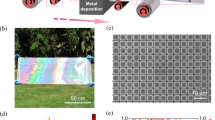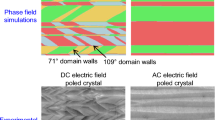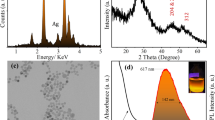Abstract
In liquid-crystal (LC) display devices, patterned electrodes are used to effect switching of molecular orientation within a pixel element, and thin layers of a material (typically a polymer) at the surfaces of the cell plates induce the liquid-crystal molecules to revert to their original orientation after the electric field is switched off1. Because of their periodic variation in refractive index, cholesteric LC phases (which have a helical variation in orientation) reflect light at a wavelength determined by the helical pitch2,3, and so can potentially be used in switchable optical devices such as shutters, reflectors and notch- and band-pass filters. But orientation layers are unable to restore the initial orientation in cholesteric phases. They can instead be given an internal ‘memory’ of their initial orientation by creating an anisotropic polymer network within the system using in situ photopolymerization4. Here we show that such crosslinked cholesteric gels can be used to produce fast electrically switchable reflectors with narrow- to broad-band widths (the latter having a silvery mirror-like appearance). By photopolymerizing in a patterned manner, we can make image recordings in the gels which become visible on application of an electric field. These patterned gels offer the prospect of making optical components such as lenses and gratings by holographic recording.




Similar content being viewed by others
References
Gray, G. W. in Thermotropic Liquid Crystals 74 (Wiley, Chichester, (1987)).
Gerber, P. R. Voltage induced cholesteric structure transformation in thin layers. Z. Naturforsch. 36, 718–726 (1981).
Schadt, M. & Gerber, P. Dielectric electro-optical and phase change properties of liquid crystal guest host displays. Mol. Cryst. Liq. Cryst. 65, 241–263 (1981).
Hikmet, R. A. M. & Lub, J. Anisotropic networks and gels obtained by photopolymerisation in the liquid crystalline state. Prog. Polym. Sci. 21, 1165–1209 (1996).
Kelker, H. & Hatz, R. in Handbook of Liquid Crystals 172 (Verlag Chemie, Weinheim, (1980)).
Broer, D. J., Lub, J. & Mol, G. N. Wide-band reflective polarizers from cholesteric polymer networks with a pitch gradient. Nature 378, 467–469 (1995).
Patel, J. S. & Rastani, K. Electrically controlled polarisation independent liquid crystal Fresnel lens arrays. Optics Lett. 16, 532–534 (1991).
Acknowledgements
We thank L. Poels for technical assistance and J. Lub for synthesis of the reactive molecules.
Author information
Authors and Affiliations
Corresponding author
Rights and permissions
About this article
Cite this article
Hikmet, R., Kemperman, H. Electrically switchable mirrors and optical components made from liquid-crystal gels. Nature 392, 476–479 (1998). https://doi.org/10.1038/33110
Received:
Accepted:
Issue Date:
DOI: https://doi.org/10.1038/33110
- Springer Nature Limited
This article is cited by
-
Efficient methodology with potential uses of Fresnel diffractometry for real-time study of uniaxial nematic liquid crystal phase transitions
Scientific Reports (2023)
-
Development of electroresponsive functional soft materials by electroresponsive dopants
Polymer Journal (2023)
-
Electrically turning periodic structures in cholesteric layer with conical–planar boundary conditions
Scientific Reports (2021)
-
Functional liquid-crystalline polymers and supramolecular liquid crystals
Polymer Journal (2018)
-
Cholesteric liquid crystal paints: in situ photopolymerization of helicoidally stacked multilayer nanostructures for flexible broadband mirrors
NPG Asia Materials (2018)





